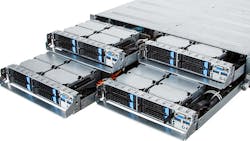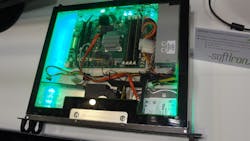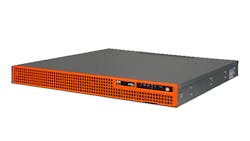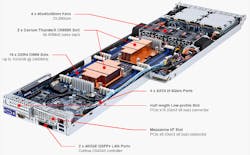ARM TechCon was host to a wide range of Cortex-based microcontrollers and microprocessors. ARM announced its latest Cortex-A35 and the ARMv8-M microcontroller architecture with TrustZone support (see “New ARM v8 Architecture for Microcontrollers” on Electronic Design). Both are forward-looking announcements that contrast with the hardware offerings at the show.
ARM’s 64-bit offerings power tablets and smartphones, but they are also moving into enterprise applications. This includes low-price, small-form factor systems like the HuskyBoard (Fig. 1) soon to be available on 96Bords.org. The board hosts an AMD Opterson A1100 with four, 64-bit Cortex-A57 cores.
The board matches the 96Boards Enterprise Edition specification. The 160-mm by 120-mm board has a pair of SO-DIMM sockets for DDR3 memory. There is one eSATA and three SATA ports along with a x16 PCI Express Gen 3 socket. There is also a pair of USB 3.0 ports and a 1 Gbit Ethernet port.
The AMD Opteron 1100 is also found in the SoftIron Overdrive 3000 that is in a rack mount case (Fig. 2). It has a pair of 10 Gbit Ethernet ports, a single x8 or dual x4 PCI Express interface, and eight SATA 3.0 ports. The system sports 16 Gbytes of DDR3 memory in a pair of RDIMM sockets. It comes pre-installed with SUSE Enterprise or openSUSE Linux, including the complete GNU toolchain.
Applied Micro Circuits (Applied Micro) was presenting its 3 generation X-Gene architecture. It is based on ARM’s ARMv8-A architecture and will employ 16-nm FinFET process. The top-end chips will host 32 cores running at speeds up to 3 GHz. There will be a complement of 42 PCI Express Gen 3 lanes as well as eight DDR4-2667 memory channels for a total of 16 DIMMs. This will deliver up to six times the performance of the current X-Gene 2 systems.
Also on display were E4 Computer Engineering’s high-performance computing (HPC) platforms based on the X-Gene 2 architecture. These include 1U and 2U ARKA systems (Fig. 3) with support for a pair of NVidia GPU boards. HPC clusters can be created using the Mellanox FDR Connect-X3 InfiniBand support. The platform was initially announced at SC14. These X-Gene 2 platforms are available now while the X-Gene 3 will not be available until 2016.
The X-Gene 1 is available on motherboards from Gigabyte. The MP30-AR0 has an X-Gene 1 chip plus eight DDR3 slots, two 10 Gbit SFP Ethernet ports, two 1 Gbit Ethernet sockets along with four SATA 3 interfaces.
Cavium was highlighting their ThunderX series. The ThunderX CP SoCs are available in configurations with up to 48 cores running at 2.5 GHz. It supports low latency Ethernet fabrics and its virtSOC virtualization technology supports virtualized I/O.
Gigabyte also has a high-density ARM Blade Server (Fig. 4) that hosts up to eight CN8890 ThunderX chips in a 2U, four-node blade system. Each blade has two 48-core CN8890s. That is 384 cores in a 4U system.
Each blade (Fig. 5) supports up to 1 Tbyte of 2400 MHz DDR4 memory. The four SATA ports are connected to the four 2.5-in. storage bays. There is a x8 PCI Express Gen 3 mezzanine slot as well as a half-length, x16 PCI Express connector with a x8 interface. The system and drives are hot-swappable. Network interfaces include two 40-Gbit Ethernet QSFP slots.
The big difference between this year and last is that the 64-bit platforms are generally available rather than just evaluation kits. It is currently a small fraction of the server market, but this is changing as the higher performance and high core-count platforms become available as they run very cool and efficiently. Linux support is standard as UEFI boot support makes the platforms as standard as their x86 counterparts.
About the Author
William G. Wong
Senior Content Director - Electronic Design and Microwaves & RF
I am Editor of Electronic Design focusing on embedded, software, and systems. As Senior Content Director, I also manage Microwaves & RF and I work with a great team of editors to provide engineers, programmers, developers and technical managers with interesting and useful articles and videos on a regular basis. Check out our free newsletters to see the latest content.
You can send press releases for new products for possible coverage on the website. I am also interested in receiving contributed articles for publishing on our website. Use our template and send to me along with a signed release form.
Check out my blog, AltEmbedded on Electronic Design, as well as his latest articles on this site that are listed below.
You can visit my social media via these links:
- AltEmbedded on Electronic Design
- Bill Wong on Facebook
- @AltEmbedded on Twitter
- Bill Wong on LinkedIn
I earned a Bachelor of Electrical Engineering at the Georgia Institute of Technology and a Masters in Computer Science from Rutgers University. I still do a bit of programming using everything from C and C++ to Rust and Ada/SPARK. I do a bit of PHP programming for Drupal websites. I have posted a few Drupal modules.
I still get a hand on software and electronic hardware. Some of this can be found on our Kit Close-Up video series. You can also see me on many of our TechXchange Talk videos. I am interested in a range of projects from robotics to artificial intelligence.






